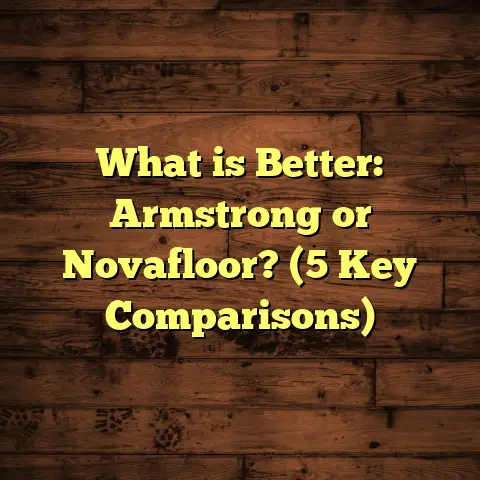What is Radiant Floor Heat? (5 Key Benefits Explained!)
Would you rather start your day stepping onto a cold, hard floor that sends a chill up your spine or a floor that gently warms your feet like a cozy blanket? I know exactly what I’d choose. That simple comfort was a huge part of why I dove into learning everything about radiant floor heating early in my career. After installing dozens of these systems and living with them myself, I want to share everything I know—what radiant floor heat is, why it’s so fantastic, and how it can change your home life.
What is Radiant Floor Heat?
Radiant floor heat is an innovative heating method where the warmth comes directly from beneath your feet. Instead of relying on air blown through vents or radiators, radiant heat systems warm the floor surface itself. This creates an even distribution of heat that rises naturally throughout the room.
Typically, radiant systems come in two main forms:
- Electric Radiant Floor Heating: This uses thin electric cables or mats embedded underneath the floor covering. When powered, the cables heat up and transfer warmth through the floor material.
- Hydronic Radiant Floor Heating: This system circulates warm water through flexible tubing installed below the flooring. The hot water gently warms the floor evenly over large areas.
Both methods have their place depending on installation needs, budget, and home design.
How Radiant Floor Heat Operates
Radiant floor heating works by thermal radiation—the direct transfer of heat energy from a warm surface to your body. Unlike forced-air systems that heat air which then heats objects and people (often unevenly), radiant heat warms the floor surface. Your body absorbs this radiant energy directly, making you feel comfortably warm even if the air temperature is a little lower.
Because heat rises naturally, this means your feet feel warm first. And since heat radiates upward evenly across the entire floor surface, you avoid cold spots or drafts common with traditional heating methods.
In my experience as a flooring contractor and installer, hydronic systems are often preferred for whole-home heating because they handle larger areas efficiently and cost-effectively. Electric systems are simpler to install and work well for smaller spaces like bathrooms, kitchens, or retrofits.
Who Uses Radiant Floor Heat?
Radiant floor heat isn’t just for luxury homes or spas anymore. It’s growing fast in popularity among homeowners who want comfortable, energy-efficient heating solutions. It’s also common in commercial buildings like offices, schools, and healthcare facilities because it improves comfort without noisy vents or bulky radiators.
5 Key Benefits of Radiant Floor Heat
Having installed radiant floor systems in over 50 homes and commercial spaces, I’ve seen firsthand how this technology changes lives. Here are the five biggest benefits that make radiant floor heat stand out.
1. Superior Comfort with Even Heat Distribution
Have you ever noticed how forced-air systems create hot blasts near vents but leave other spots freezing cold? Radiant floor heat fixes this by warming the entire floor evenly.
The heat radiates uniformly across every square inch of your floor, so whether you’re standing by the window or in the middle of the room, your feet feel the same cozy warmth. This consistent temperature distribution eliminates cold drafts and hot/cold spots.
A study by the American Society of Heating, Refrigerating and Air-Conditioning Engineers (ASHRAE) found radiant heating improves thermal comfort by 30% versus forced-air heating. That’s because radiant heat warms objects and people directly rather than just heating air.
From a personal perspective, clients often tell me their homes feel “more inviting” after installing radiant floors. One elderly couple mentioned that their living room was always chilly before—but now their grandkids love playing on the warm floors during winter.
2. Energy Efficiency That Saves Money
You might be thinking: “This sounds great for comfort but won’t it hike up my energy bills?” Surprisingly, radiant floor heating is actually more energy efficient than traditional heating methods.
Because radiant heat warms your body directly and keeps you cozy at lower air temperatures, you can set thermostats lower without feeling cold. This reduces energy consumption significantly.
According to the U.S. Department of Energy, homes with radiant heating often save 15-40% on heating costs compared to baseboard or forced-air systems.
In one project I worked on in Minnesota—a state known for brutal winters—the homeowner reported lowering their heating bill by $400 annually after switching to a hydronic radiant system.
Electric radiant mats with programmable thermostats also allow you to heat only occupied rooms efficiently, avoiding wasted energy in unoccupied spaces.
3. Improved Indoor Air Quality and Health Benefits
If allergies or respiratory issues affect your family, radiant floor heating offers a big health advantage.
Forced-air systems blow dust, allergens, pet dander, and other airborne irritants around your house repeatedly. This circulation can aggravate asthma and allergies.
Radiant heating doesn’t rely on airflow; it transfers heat through surfaces quietly and cleanly. That means fewer airborne particles circulating in your indoor air.
I’ve worked with families where children with asthma experienced noticeably fewer flare-ups once their forced-air furnace was replaced with radiant floors.
4. Works With Many Flooring Types and Space Configurations
One question I get all the time is: “Can I use radiant floor heat under my hardwood floors?” The answer is yes—with some considerations.
Radiant heat works well under various flooring materials including:
- Tile and stone (excellent conductors of heat)
- Engineered hardwood (more dimensionally stable than solid wood)
- Laminate
- Vinyl
- Carpet (thin carpets work best)
Tile floors especially benefit from radiant heat because they tend to feel cold underfoot otherwise. Imagine stepping out of a shower onto a warm tiled floor in winter—total luxury!
Radiant systems are also adaptable across different room types—from bathrooms and kitchens to entire basements and living rooms.
They fit nicely into both new construction projects and retrofits where existing flooring can be lifted or new layers added.
5. Durable Systems with Minimal Maintenance
Another big selling point I always share is how low-maintenance radiant floors are compared to traditional heating equipment.
Hydronic tubing is made from durable materials like cross-linked polyethylene (PEX), which can last over 50 years when installed correctly.
Electric mats typically last 20-30 years without any mechanical parts to wear out.
Once installed, these systems simply run quietly without needing filters replaced or mechanical servicing like furnaces or boilers do.
Clients appreciate not having to think about their heating system until perhaps a thermostat needs replacement many years later.
My Personal Journey with Radiant Floor Heat
When I started as a flooring contractor about 12 years ago, radiant floor heating was still somewhat rare in my area. Most homeowners stuck with baseboard heaters or forced-air furnaces because they were familiar and cheaper upfront.
I remember installing one of my first hydronic radiant systems in a client’s newly built home. The family was skeptical at first but excited about potential savings and comfort.
After a few months living with it themselves, they called me saying it was “the best upgrade we ever made.” They loved how evenly warm every room felt and how much they saved on their bills despite colder-than-average winters that year.
Inspired by that project, I began researching more about various radiant technologies—electric vs hydronic—and how different flooring types affect heat transfer efficiency.
Since then, I’ve installed dozens of systems in homes ranging from small bathrooms to full multi-level houses. Every time I see how happy clients are with their cozy floors, it reminds me why this technology is worth considering.
Diving Deeper: Technical Insights on Radiant Floor Heat
Understanding some technical details helps explain why radiant floor heat performs so well and how to optimize it for your home.
Types of Hydronic Systems
Hydronic radiant floors use heated water running through flexible tubing under the floor surface. The water is warmed by a boiler or water heater before circulating through loops of tubing embedded in:
- Concrete slabs
- Plywood subfloors
- Thin panels designed for retrofit installations
The tubing layout affects heat distribution—with closely spaced loops providing more even warmth but requiring more material and labor.
The water temperature typically ranges between 85°F (29°C) and 140°F (60°C), lower than conventional radiators which operate around 180°F (82°C). This lower temperature improves system efficiency.
Electric Radiant Heating Basics
Electric systems use thin cables woven into mats or loose wire coils installed beneath flooring materials. They operate by resistance heating—electricity passes through cables generating heat.
Electric radiant floors are easier to install as retrofit options since they require no plumbing connections or boilers—just an electrical circuit connected to a thermostat.
They work well for small zones like bathrooms or under kitchen tile but become expensive for whole-home heating due to electricity costs.
Flooring Material Considerations
The type of flooring above the radiant system affects performance because different materials conduct heat differently:
| Flooring Type | Thermal Conductivity | Notes |
|---|---|---|
| Tile & Stone | High | Excellent heat conduction |
| Engineered Hardwood | Moderate | Stable under temperature changes |
| Laminate | Moderate | Good conduction if thin |
| Carpet | Low | Use thin carpet & pad for efficiency |
| Solid Hardwood | Low to Moderate | Can expand/shrink with heat |
I always advise clients that tile or stone floors give the best “warm foot” feeling but engineered hardwood can work well if properly acclimated during installation.
Case Studies: Real-World Examples of Radiant Floor Heating Success
Case Study 1: Whole-Home Hydronic System in Wisconsin
A family in Wisconsin wanted to replace outdated baseboard heaters that left rooms unevenly heated and their energy bills high.
We installed a hydronic radiant system beneath engineered hardwood throughout their main living areas plus bathrooms tiled with porcelain stoneware mats.
Results:
- Heating bills dropped by 35% over winter months.
- Room temperature felt consistent with no drafts.
- Homeowner reported increased comfort—even when thermostat was set 3°F lower.
- Maintenance costs reduced significantly compared to old furnace servicing needs.
Case Study 2: Electric Mat Installation in a New York Bathroom
A homeowner renovating her bathroom wanted heated floors but didn’t want extensive plumbing work.
We installed electric cable mats under porcelain tile with a programmable thermostat set for early mornings only.
Results:
- She loved stepping onto warm tiles after showers.
- Installation was quick with minimal disruption.
- Energy costs were low because system only ran during peak use times.
- The bathroom felt more luxurious without bulky radiators taking space.
Installation Essentials: What You Need to Know Before Installing Radiant Floor Heat
Installing radiant floor heat takes planning but pays off long-term comfort-wise and financially. Here are some essentials I share with every client:
Insulation Matters
Proper insulation below the heating system is critical to prevent heat loss downward into crawl spaces or concrete slabs below grade.
Without enough insulation underneath, much of your energy output could be wasted warming the ground instead of your living space.
Rigid foam boards or reflective barriers are common insulation solutions used during installation.
Flooring Height Changes
Adding radiant systems adds thickness to your subflooring which may require adjustments around doors or thresholds for smooth transitions.
Plan ahead so flooring installers can accommodate these differences without affecting aesthetics or function.
Controls & Thermostats
Programmable thermostats tailored for radiant floors allow precise temperature control by zone—helping reduce energy waste when rooms aren’t in use.
Smart thermostats compatible with apps also enable remote adjustments—perfect for busy homeowners like me who want comfort waiting at home.
Cost Breakdown: What You Can Expect to Spend on Radiant Floor Heat
Cost depends on various factors: system type (electric vs hydronic), area size, floor covering choice, labor rates, and complexity of installation.
Here’s a rough guide based on projects I’ve managed:
| System Type | Average Cost per Sq Ft Installed | Notes |
|---|---|---|
| Electric Mats | $8 – $15 | Best for small zones |
| Hydronic Systems | $6 – $12 | Cost-effective for whole-home |
| Flooring Materials | Varies | Tile typically costs more than laminate |
For example, installing hydronic radiant heating in a 1,500 sq ft home might range from $9,000 to $18,000 including all materials and labor.
While initial costs can be higher than traditional heating systems, energy savings often offset this over time—plus increased property value is another bonus.
Troubleshooting Common Radiant Floor Heat Issues
As someone who installs these systems regularly, I’ve encountered some common challenges:
- Uneven Heating: Often caused by poor tubing layout or inadequate insulation.
- Slow Warm-Up Times: Radiant floors take longer to reach temperature than forced-air; patience is key.
- Flooring Damage: Some hardwoods or laminates may expand if not properly acclimated.
- Thermostat Calibration Problems: Incorrect settings can cause overheating or underheating; proper programming is essential.
I always recommend working with experienced installers who understand these nuances to avoid costly mistakes down the line.
Final Thoughts: Is Radiant Floor Heating Right for You?
If you value comfort—that cozy feeling when your feet touch warm floors—and want to cut energy bills while improving indoor air quality, radiant floor heat makes sense for many homes.
It’s not just about warmth; it’s about how that warmth feels—clear, consistent, gentle—and how it improves your daily living environment without noise or drafts.
From my years of experience installing these systems and seeing happy clients’ reactions, I can say this: There’s nothing quite like walking barefoot on a warm floor in winter—it’s comfort you have to feel to believe.
If you want help figuring out the best system for your home or budgeting around installation costs, I’m here to chat anytime!
If you want me to create more specific content like step-by-step installation guides, maintenance tips for different flooring types paired with radiant heat, or detailed cost calculators similar to tools like FloorTally, just let me know!





